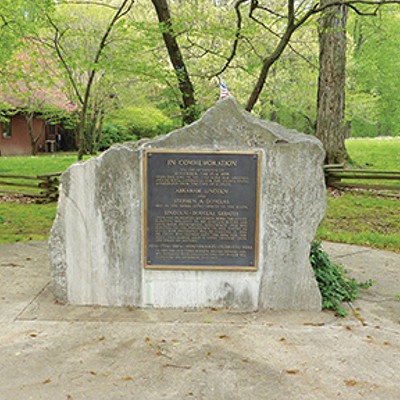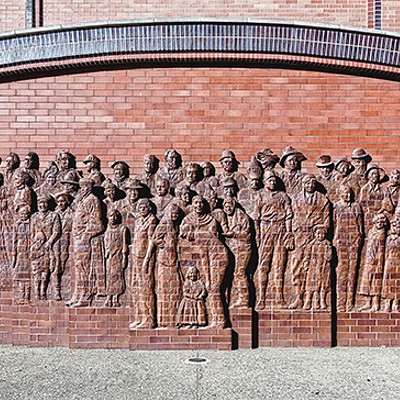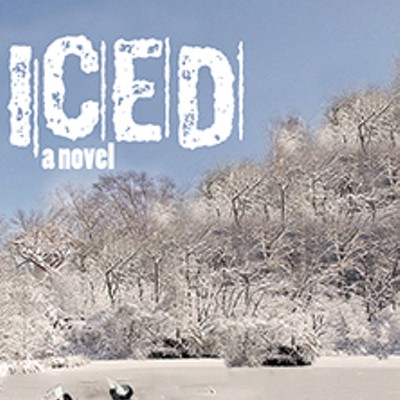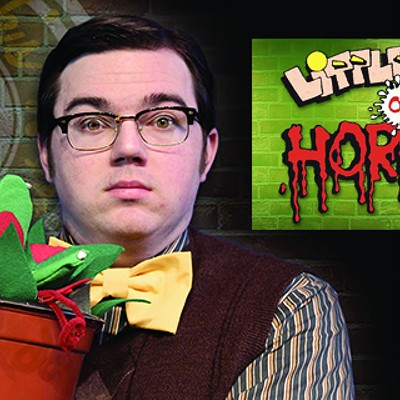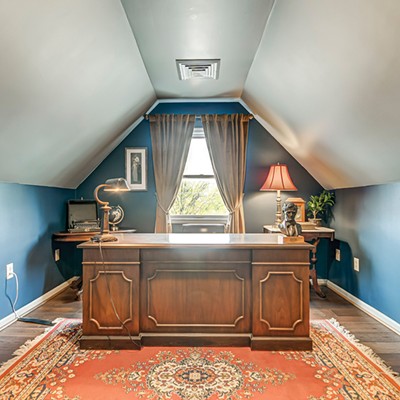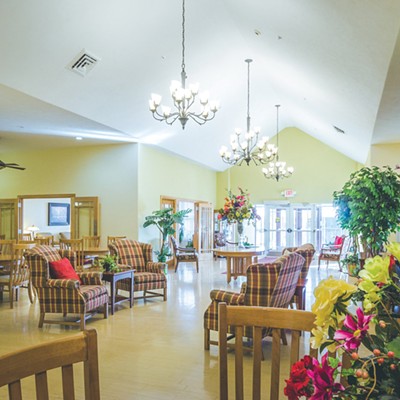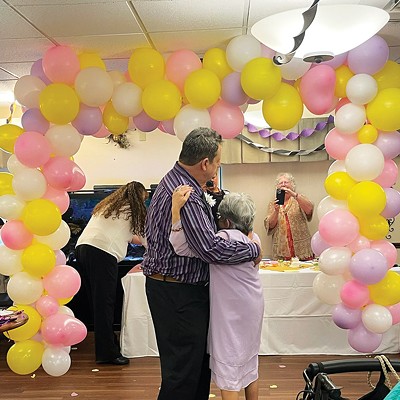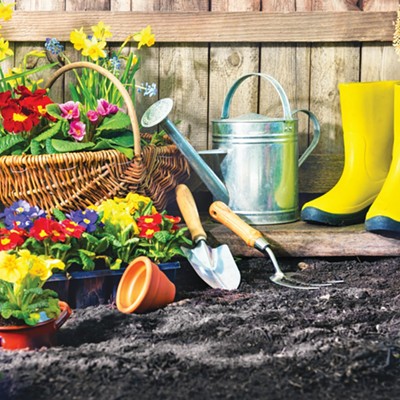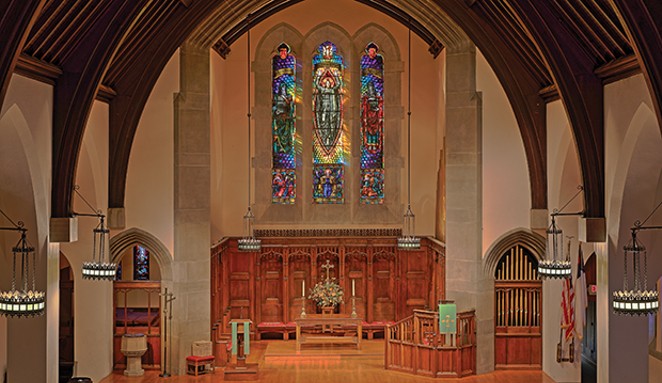
Springfield is home to gorgeous stained glass installations in churches, historic sites and other public spaces. Architect Ralls Melotte, co-founder of Melotte Morse Stained Glass and Melotte Morse Leonatti Parker, Ltd. Architects, spent 21 years restoring, repairing and fabricating much of it. Here, Melotte presents several examples of Springfield’s wide range of transcendent light.
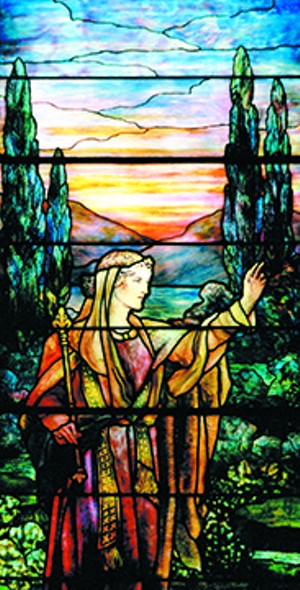
“For more than 500 years, design and construction of stained glass art varied little,” Melotte begins. “But in the 1800s, the Arts and Craft Movement inspired a new interest in Gothic styles in Europe and ushered in the production of stained glass on America’s East Coast. Midwestern mainline churches that could afford contracts with these studios brought that early Gothic style to central Illinois. By around 1890, studios in smaller communities had started creating their own new styles. We are fortunate to have a wide variety of art glass in and around Springfield.”
Gothic style
Westminster Presbyterian Church, Walnut and Edwards
“In the early 1900s, Westminster had one significant stained glass window with remarkably vibrant colors in the chancel designed by a Boston studio. Between the 1930s and 1960s, the church commissioned additional windows by the Connick Studio of Boston which show the original method of painting almost every individual piece of glass with frit – ground black glass fired onto handblown glass. Although the windows were built and installed over a period of nearly 60 years by three different studios, an attempt was made to have all the windows relate to each other.”
First Presbyterian Church, 321 S. Seventh, the non-Tiffany windows
“Built at the time the Lincolns lived in Springfield, the original windows featured a simple grid of stained glass. Around the turn of the 19th century, the church incorporated Tiffany panels in the sanctuary. Later, the church commissioned a different East Coast studio to produce the remaining windows along the north and south elevations of the sanctuary in a more medieval style. Although these windows look like the oldest, they are the newest in the collection.”
Blessed Sacrament Parish, 1725 S. Walnut
“This is a remarkable example of the European influence on stained glass design in the early 1900s. Unlike many Gothic-style windows produced in America, these windows are comprised of many small pieces of glass, rather than larger pieces painted to appear as small pieces.”
American late 1800s stained glass domes
Illinois State Capitol dome, skylights and barrel vault, 401 S. Second St.
“As part of the entire rotunda dome restoration in 1986, working hundreds of feet in the air, our studio removed the skylight, cleaned off the black soot from a major fire, and rebuilt the artist’s rendition of the State Seal. This beautiful example of Art Nouveau only uses symbolism in the center of the skylight. We also restored all the skylights in the stairways and the beautiful, big barrel vault over the grand stair.” Brooks Art Glass would later replace the glass in the Senate Chamber.
Art Nouveau installations
The style is exemplified generally by pictorial designs and graceful curves. Most Art Nouveau designs in glass did not use paint except for the rendition of hands, feet and faces.
First Presbyterian Church, Tiffany windows
“The Tiffany panels in the First Presbyterian Church show the progression of Louis Comfort Tiffany’s designs and techniques across 40 years, from the 1890s through late 1920s. For these, Tiffany developed the mild, subtle colors in his opalescent glass seen in the northwest windows, into the brilliant splashes of color found in the southeast window. He used multiple layers of glass for depth of color and the illusion of distance as seen in the angels in the southwestern window. Tiffany used as many as seven layers of glass in the circular descending dove window over the narthex, made Favrille glass that varied in thickness with folds and ripples to simulate fabric, and glass with mottled shapes that looked like realistic vegetation. These were the first windows that actually looked three-dimensional.”
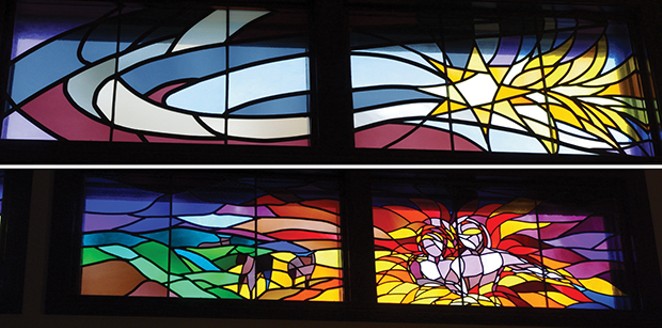
Contemporary installations
Third Presbyterian Church, 1030 N. Seventh
“The majority of the windows in Third Presbyterian Church was designed by one studio and reflect the use of hand-blown (antique) glass and a variety of widths of lead lines. The linework of the lead defines the style of the windows along with large-enough pieces .



